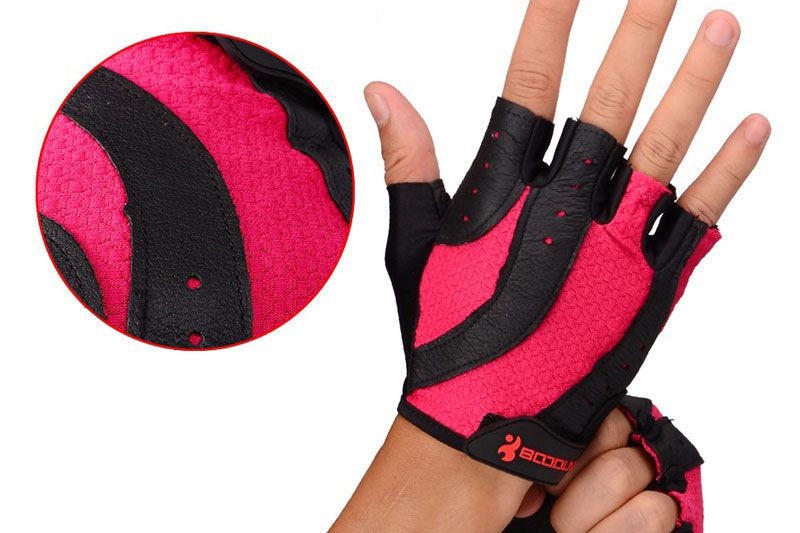Polyester is the main material of gym gloves and the trade name of polyester fiber in my country. It is a fiber-forming polymer made of purified terephthalic acid (PTA) or dimethyl terephthalate (DMT) and ethylene glycol (EG) through esterification or transesterification and polycondensation reaction— —Polyethylene terephthalate (PET), a fiber made by spinning and post-processing
Dyeing technology
Stained
During high temperature and high pressure dyeing, the dyeing process of disperse dyes on polyester fibers can be divided into the following stages:
(1) Disperse dyes gradually approach the fiber interface with the flow of the dyeing solution in the dyeing solution. At this stage, the nature and state of the disperse dyes are basically irrelevant. The dissolved dye molecules and suspended dye particles are the same with the dyeing solution and the transfer speed Determined by the solution flow rate.
(2) Since there is a dynamic boundary layer that is not easy to flow on the fiber surface, when the disperse dye enters the dynamic boundary layer and approaches the fiber interface, it will approach the fiber mainly by its own diffusion. The transfer speed at this stage is not only related to the flow rate of the solution, but also related to the diffusion speed of the disperse dye. Therefore, the dissolved dye molecules diffuse much faster than the suspension and aggregates. The solubility and dispersion state of the disperse dye affect the transfer speed at this stage. Have a greater impact.
(3) When the disperse dye is close to the fiber interface and the molecular force between them is large enough, the disperse dye is quickly absorbed by the fiber surface. The transfer speed at this stage is mainly determined by the structure and properties of the fibers and dye molecules, and is also related to the nature of the interface solution. Among them, the solubility and dispersion state of the dye have a greater impact. The higher the solubility of the dye and the greater the interaction between dye molecules and fibers, the faster the adsorption speed.
(4) After the disperse dye is adsorbed on the fiber surface, a concentration difference or chemical position difference between the inner and outer dyes is generated in the fiber, and the dye will diffuse into the fiber. The diffusion speed here is mainly determined by the fiber chemistry and microstructure, and also the dye molecule. Structure and concentration are related. The fiber has a higher content of amorphous regions, large pores or more free volume, high dye solubility, and fast diffusion. Therefore, the dye diffusion rate at this stage is directly related to the degree of swelling or plasticization of the fiber and the concentration of disperse dye in the fiber . The degree of swelling or plasticization is high, and the concentration of the disperse dye in the outer layer of the fiber is high, and the diffusion is fast. It can be seen from the above that, in addition to the dye and fiber structure, the dyeing speed is also related to the solubility of the dye in the solution and the degree of swelling or plasticization of the fiber during dyeing. Polyester fiber is a hydrophobic synthetic fiber. The molecular structure of polyester lacks active groups that can bind with dyes like cellulose or protein fibers. Polyester molecules are arranged relatively tightly, and there are only small voids in the fiber. When it is low, the thermal motion of the molecules changes its position to a smaller extent. Under humid conditions, polyester fibers will not increase the gap through violent swelling like cotton fibers, and it is difficult for dye molecules to penetrate into the fiber. Therefore, increase the degree of plasticization of the fiber
Will help the dyeing process. In addition, the solubility of disperse dyes in water is very low, and the dyes in the dyeing solution must be dispersed in the dyeing bath in suspension by a large amount of dispersant. In order to achieve a better dyeing effect when dyeing polyester fibers, a certain amount of dyeing auxiliary is usually added. The functions of these dyeing auxiliaries in the dyeing process are multifaceted, mainly:
(1) Appropriately increase the solubility of disperse dyes;
(2) Promote the adsorption of disperse dyes on the fiber surface;
(3) Plasticize the fiber or increase the degree of swelling to speed up the diffusion of disperse dyes in the fiber;
(4) Improve the dispersion stability of the dye
Generally, the auxiliaries used in high-tamp and high-pressure dyeing of polyester fibers contain a carrier that plasticizes the fiber, and a surfactant that solubilizes disperse dyes or stabilizes the dye suspension. Dyeing auxiliaries for polyester fiber dyeing play a very important role. Counter-dyed polyester fibers and filament fabrics have strong hydrophobicity. The usual dyes and dyeing methods can hardly be dyed and can only be dyed with disperse dyes. But the whole process of such dyeing can only be completed under high temperature and high pressure.
BOODUN fitness gloves protect your hands fully. The waist support can protect your arms from spraining. And the pad on the palm will buffer the impact of sport apparatus. Most of all, different from other general gloves, the palm of BOODUN Gloves are made of micro fiber which will be not easy to be destroyed.
Fitness gloves are more breathable .The back of hands are made of spandex fiber which is a light and breathable fabric. And the gloves use the professional design. So the gloves will keep your hands dry and comfortable.
Under this strict process, what are the advantages of BOODUN fitness gloves?
BOODUN gym gloves use humanization design. The gloves will be easy to take off for the LOOPS on the finger. And the TERRY CLOTH on the thumb can help wipe sweat off during training or doing other exercise.
BOODUN gloves are suitable for women, men, adults and teenagers to Weight Lifting, Pull Up, Exercise, Fitness, Gym Training and General Workouts.
